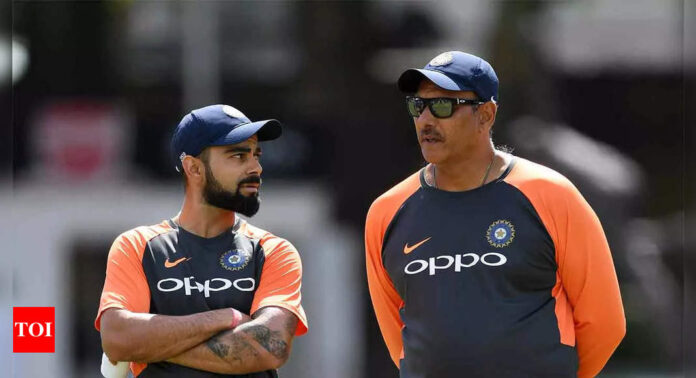Former India coach. How does that sound…
Not bad at all. Seven years I’ve been on the move, and it’s been an absolute rollercoaster. As a media professional too, life had always been on the move. It feels good to be spending time at home, with mom, with the family.
Seven years is a lot of time to collect a bag of memories…
I don’t really know when and where to begin. 2007? I was literally asked to set everything aside and be with the team when they came back from that shock exit in the World Cup. And then, before I knew, things were back on track, and everything was fine.
Bharat Arun, Ravi Shastri and Virat Kohli. (ANI Photo)
2007, 2014, 2017…
In many ways, I thought, I was a mistake doing this job because I wasn’t cut out to do this. It was destiny. Indian cricket was not in good shape again after back-to-back overseas losses between 2012 and 2014. They were languishing back of the table across formats. Badly beaten overseas – 4-0 in England, 4-0 in Australia and again down in England.
I had just signed a fresh contract the broadcaster (Star) when the BCCI asked me to come on board, there was no contract offered. It was just word of mouth. But there was this certainty in N Srinivasan’s voice, just the way it was when Sharad Pawar had asked me to head the National Cricket Academy (NCA) in 2007.
These men insisted politely but there was firmness, and I must thank them for the opportunities.
In 2014, when Srinivasan asked me to come on board as director, I told him to ‘give me a day to think this out’. Once I was convinced that I was willing to take up this challenge, the next bit was, how do I convince the broadcaster. But before I could even take this up with Uday Shankar, he had already cleared the decks for me.
This was the last day of the Oval Test match in 2014 – the third day when the game got over.
The only big picture they had in mind at that time was to get the house back in order and instill a sense of firmness and self-belief back in the players, let them know they’re far better than what the score lines suggested.
BCCI entrusted me with the entire responsibility of picking my own support staff. I literally had the whole confidence of the Board, so I jumped into the deep end.
Did you know what to expect from the team…
Barring interviews on television (with players), I knew nobody except probably MS Dhoni because I had worked with him in 2007. There was nobody from my generation, there was nobody from the immediate generation after me. For instance, I had a connect with players of the previous decade – Sachin, Rahul, Sourav, Anil. That generation was gone.
So, once I came on board, my first challenge was to identify someone who could walk the talk and I found in Virat Kohli the guy with the character, game and personality to step into Dhoni’s shoes.
Virat was reeling from that tour of England because he hardly got runs. He was in a state of shock the way things had panned out. But you could see there was still enough there to get him going. Once he was back on his feet, there would be no looking back.
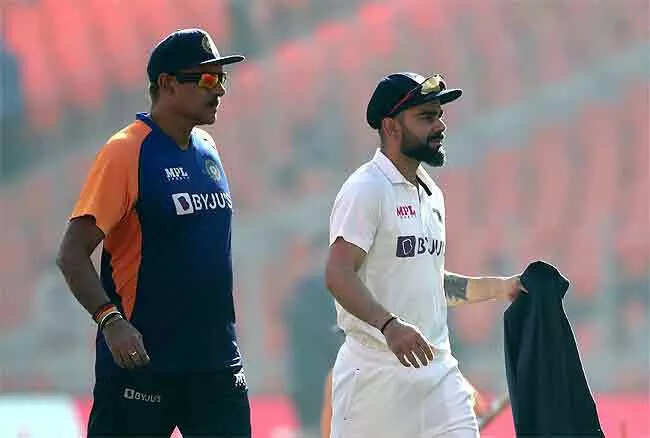
Ravi Shastri and Virat Kohli. (Photo by Surjeet Yadav/Getty Images)
Your bond with Virat has been special…
I began watching him very closely. The more closely I saw him, I could see his sense of confidence returning back with each day. Those initial two-three months went in getting to know the team better.
We began talking a lot, on various issues – batting techniques, the path forward, lot of things. And I think, it really came to the surface in Australia, when he finally bought into everything we discussed. He was absolutely ready to walk that talk – not just in the way he played his game but the way we wanted the team to play.
What was that way? A very aggressive style of cricket, in your face cricket, where you were never out there to please others. The whole focus was to do whatever it takes, do whatever is right, within the laws of the game, to win.
He set the bar really high on that tour, got four centuries and a fifty. We lost that series 2-0 but I still remember Alan Border walking up to me at the end of the series in Sydney and said: “Rav, well done man. Not many teams bat out the last day to save Test matches at the colosseums, which is Melbourne and Sydney.
And mind you, this after a close first Test in which he got a hundred in each innings and really cemented the way he wanted to play in Australia – a good, aggressive brand of cricket. The way we went for the chase of 360-plus on the final day of that Test showed what kind of cricket we wanted to play.
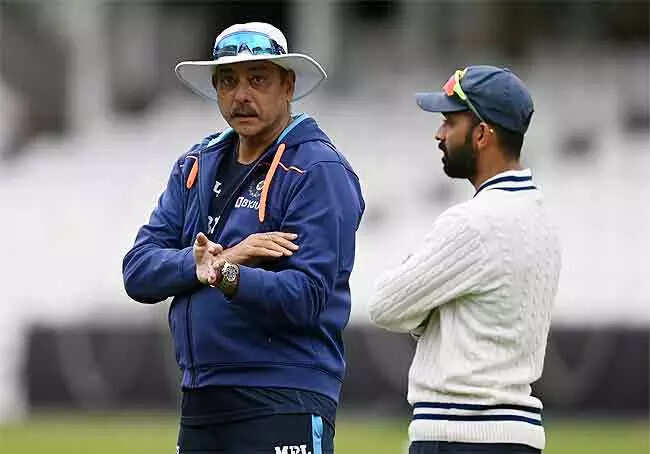
Ajinkya Rahane and Ravi Shastri. (Photo by Gareth Copley/Getty Images)
It’s been absolutely worth your while…
When I look back at the wheel over seven years – It started with a team looking to chase 360-plus and falling short by 40-odd runs. And in 2021, the team goes after 328 and gets it.
So, for me, that’s the legacy of the team that I got to spend time with. With that Test in Adelaide (2014), we sent out the message “that’s the kind of cricket we were looking to play”.
The transition from MS to Virat had also happened.
The next big move, from the team management’s perspective was – What do we have to do to win matches?
And then, there was this bolt from the blue. In less than two years after I was asked set aside my broadcast career, leave everything else and join the team, I suddenly found myself out for no reason. I had sown the seeds and the fruits were beginning to show and out of nowhere I came to know I was being replaced. Nobody told me why.
It hurt badly…
Yes, more than anything, it hurt because of the manner in which it was done. For all that I had contributed, just on one word from the BCCI, there were better ways to let me know “Oh look we don’t want you, we don’t like you. We want somebody else – if that was the case. Anyway, I went back to do what I do best – which is television.
Around nine months passed, and I didn’t even have a clue that there was anything wrong inside the team. I mean, what could’ve been wrong? I was told there was a real problem and I said – how can there be a problem in nine months?
The team that I had left was in such a good space. How the hell in nine months could something go that drastically wrong?
During my second stint, I came after a huge controversy. And it was literally egg on the faces of those who wanted me away. They opted for someone and nine months later, they came back to the very guy they threw out.
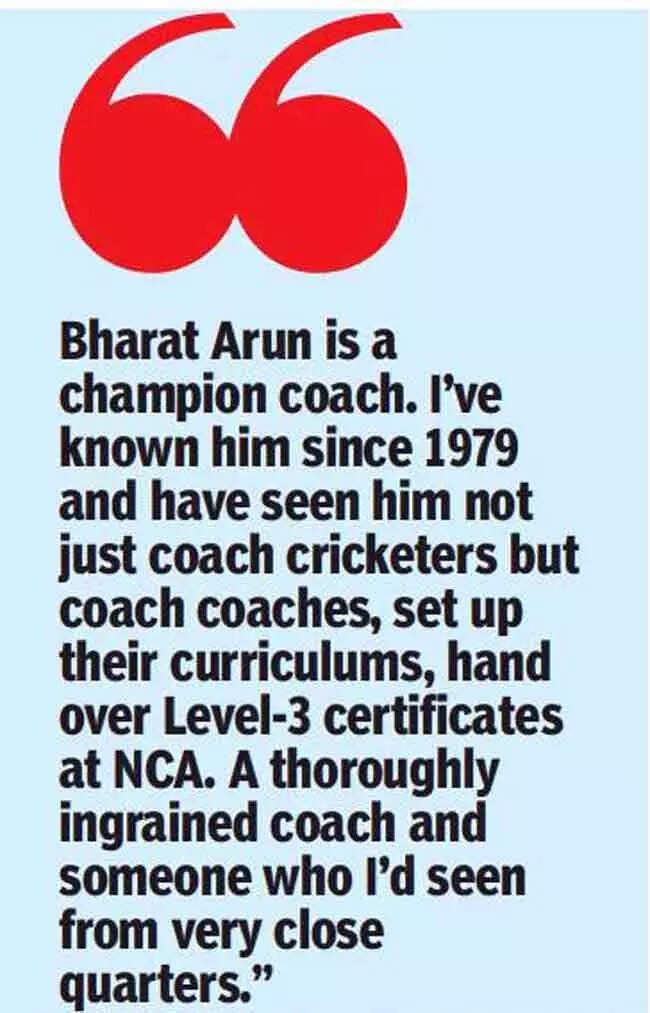
There are individuals who didn’t want Bharat Arun to come on board…
Yes. They didn’t want to give me Bharat Arun either as the bowling coach. And looking at how things pan out – the very guy they didn’t want as the bowling coach went on to become the finest this country has ever had.
And I’m not pointing any fingers at people in general. Specific people. I must say an attempt was made to ensure I don’t get the job. But such is life.
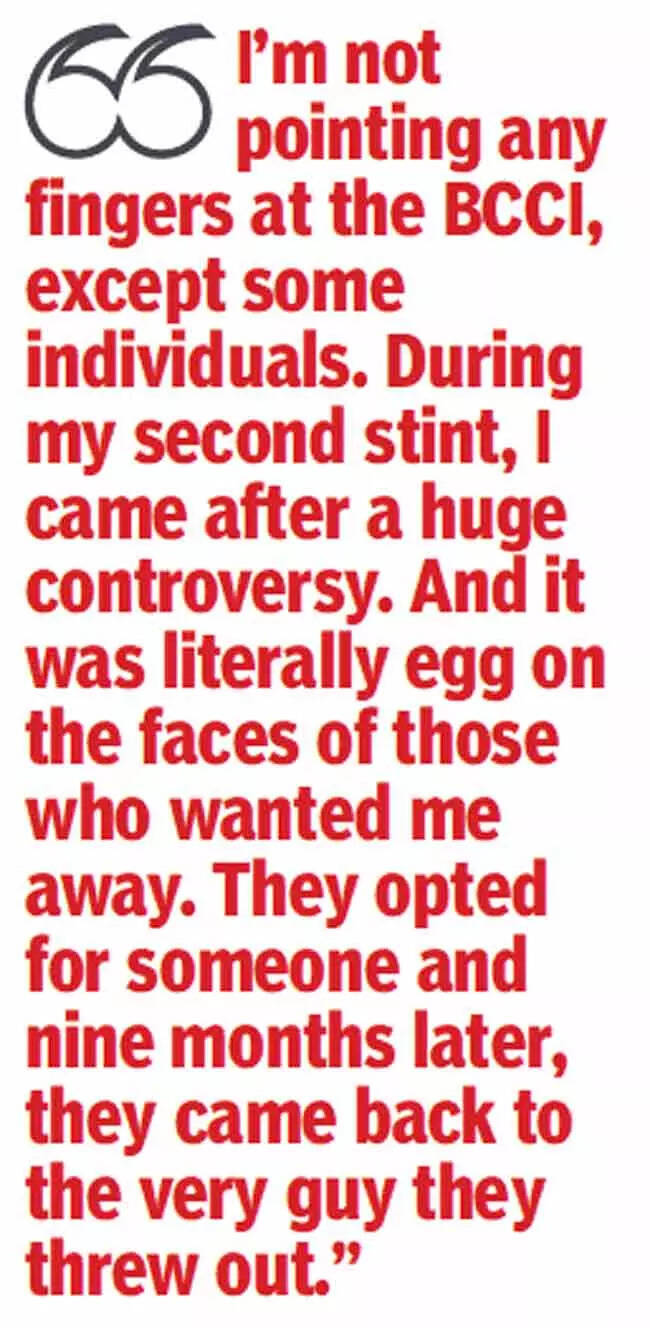
But things eventually fell in place, and then you had your task cut out…
Yes, so, I found myself back in the saddle. The first thing I did this time, after coming back for the third time, was sat and went through the itinerary. What was coming up over the next five years was deadly. There was hardly any cricket at home. It was all away.
I said ‘listen man, we could be like a punching bag here and get hammered or we do something drastic about it. I knew there was talent, experience – all that we needed. The first idea was a simple one – how could we tell the opposition know we could compete if we couldn’t let them know that we can bowl them out twice in a Test.
So, that’s when the hunt started to identify fast bowlers. And when I’m saying fast bowlers – it wasn’t just skill we were looking at. Fast bowlers with the right attitude, with pace, aggression, deceit. And we would need variety.
The tall Ishant, the open-chested Jasprit, classical side-on Shami, the fast and able Umesh Yadav and we set out to play with five bowlers all the time.
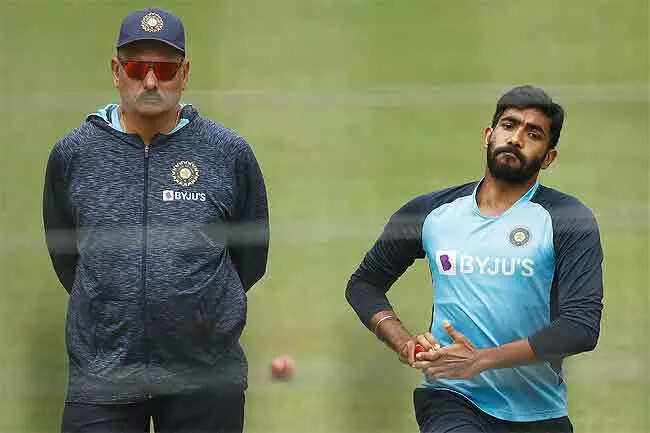
Ravi Shastri and Jasprit Bumrah. (Photo by Daniel Pockett/Getty Images)
The focus on fast bowlers is understandable but any particular reason why you made it the most important factor…
It came a lot from my own experience as a player and what I saw around me. Clive Lloyd’s West Indies of the 80s would be our inspiration. That meant added responsibility on batting.
My mind was very clear, it was only going to be pace that’s going to bring us back and the guts to play five bowlers. That began changing everything for us. The kind of cricket we set out to play was automatically much more aggressive than what any other team had played in a long time.
You could see the intensity on the field. You could see home crowds overseas appreciating the way we approached our cricket.
I had seen Jasprit in one-day cricket and what he had been doing with the Mumbai Indians. Then I said to myself, here’s a guy with an action that is open-chested, which is into the rib-cage – the kind of action that has troubled the world ever since cricket started. That’s the kind of action – guys with big open-chested action hitting the ribcage – that made the West Indians of the 80s so lethal.
Bumrah had an action with batsmen would find hard to pick. We had three to four experienced fast bowlers already in Ishant, Shami, Umesh and Bhuvi, so we (me & Bharat Arun) said – ‘why not slip this guy in and let him learn the trade out in the middle’.
His first task was to be out there to surprise, not give any rhythm to the batsmen.
Cape Town was on my mind almost two months before we had landed there. Me and Arun were at a function in Kolkata during Durga Puja when I called Jasprit. It was September 2017, and I told him to be ‘ready’ for SA. That guy couldn’t believe – all he said was ‘playing Test cricket is my dream’.
It was around 7.30 in the evening. We had not told anyone until then. The first people I then spoke with were the selectors and Virat and told them – this boy is playing the Cape Town Test.
I knew if we had to unleash him, unleashing him early on in the series was going to be the key.
The spell he bowled in the second innings at Cape Town – that’s just what we had expected him to do. And that was just the start.
He’s a quick learner and has a good attitude. The only other bowler in India who took the same amount of time to declare himself to the world – that here’s a great – was Kapil Dev.
The world stood up and took note of the Indian attack. We were not going to be on a tour anymore to make up the numbers – that was the message that got passed on.
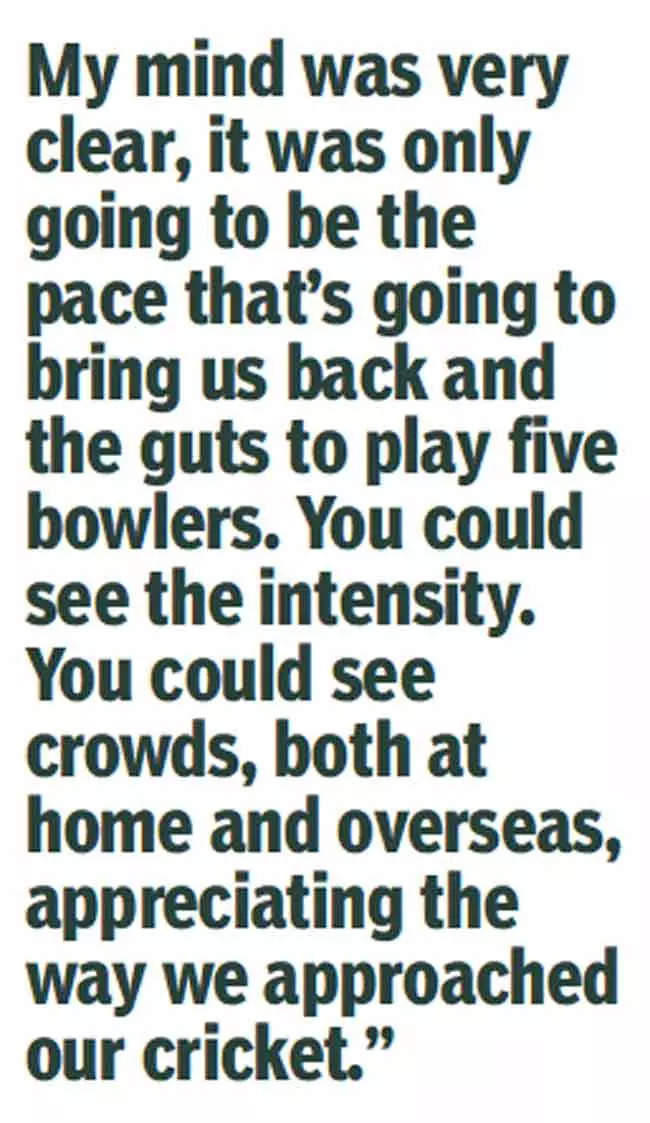
The South Africa series result should’ve read differently…
We were there to play and win. The Cape Town Test was close, and we should’ve won that. Centurion we got outplayed and then we played out of our skin in Johannesburg. That Jo’burg Test the one that instilled belief in this team that it could play regardless of a green top, regardless of the opposition.
SA wanted to call off play because of a supposedly dangerous wicket and we said, ‘we’re having nothing of that’. I told the guys – you lose bloody 3-0 and I don’t care but we’re not leaving this game. I was okay with losing.
Why just South Africa. We went to England and lost 4-1 but truth be told, we could’ve won three in that series. In those eight Test matches we played, we lost six and won two. Ideally, we should’ve had another two Tests in our kitty.
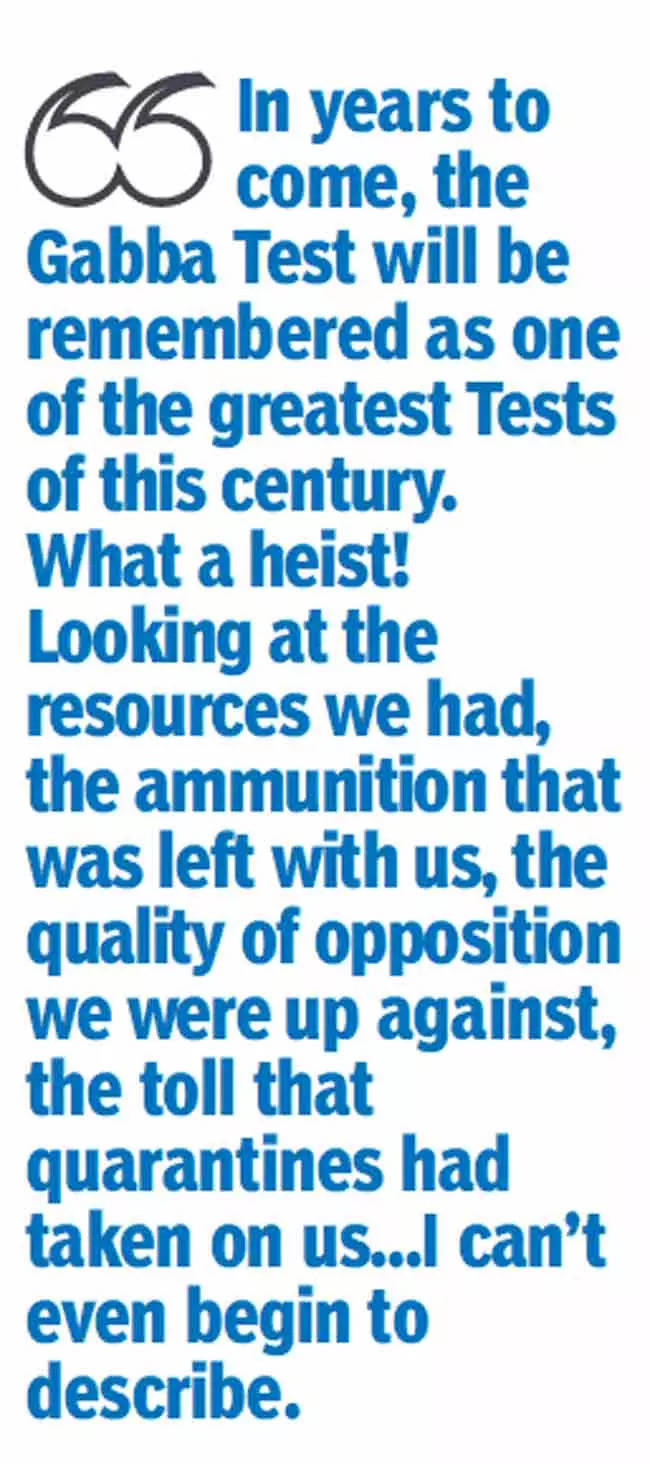
And then Australia happened…
By then I also realized one thing right – this was the start we were looking for, an Indian team in the making.
From that moment on, we started on a journey that continues and played some of our best cricket. To go back to Australia and beat them again – back-to-back – was epic. As time goes by, that Gabba Test will be remembered as one of the greatest Test matches of this century. What a heist!
Looking at the resources we had, the ammunition that was left with us, the quality of opposition we were up against, the toll that quarantines had taken on us – I can’t even begin to describe.
When did you make up your mind to quit?
Later, sometime before we left for England this year, I had made up my mind to move on. What precipitated it was a couple of reasons. First, I was pushing 60 and there were these Supreme Court rules and all.
Second, I knew the quarantine and the bio-bubbles won’t go anywhere for another two years. Cricket will be played in isolation and that’s what we’re seeing right now too.
So, I said enough. For how long will this carry on?
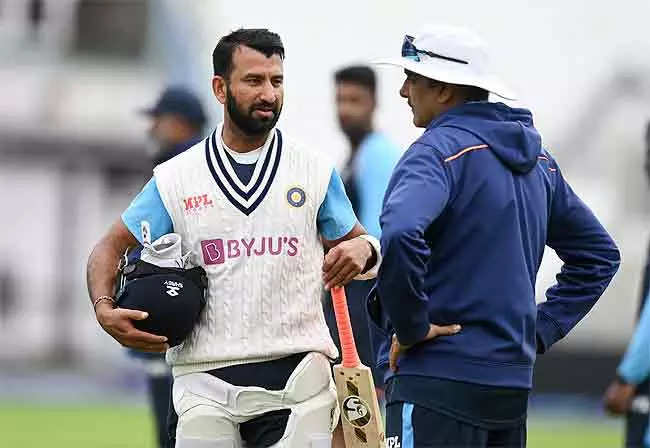
Cheteshwar Pujara and Ravi Shastri. (Photo by Gareth Copley/Getty Images)
We should’ve won the WTC final…
There are so many firsts this team has achieved. Yet, there’s disappointment. With this kind of a team, we failed at not one, two but three ICC trophies. But the one that rankles me most is the ICC Test championship. We had dominated and were No.1 for five years and we didn’t deserve to lose the one-off game.
We went through quarantine. New Zealand were better prepared. They had just won the series against England in England. Conditions suited them like home. But we should’ve at least drawn it, especially after beginning at 60 for no loss.
That loss disappointed me no end.
Our other best chance was the 2019 World Cup. I’m not so rankled by the 2021 T20 WC exit – to be honest we weren’t among the best sides. But 2019 hurts equally bad. The start we had, then the game being carried on to the next day.
But barring these two blips, it’s been one heck of a ride. If you’d told me in 2014 this is where I’d be in 2021 – you might not win a World Cup, but these are among the other things you’ll achieve – I’d say, ‘give it to me any time’.
Go and ask anyone which has been the best side in the world in the last three years and they’ll say India. Ask an Englishman, ask the Aussies and they’ll tell you – which for me is the ultimate accolade. And that cannot come without Test cricket.
These bunch of guys, when they’re done playing, someday they’ll look back and realize what they achieved.
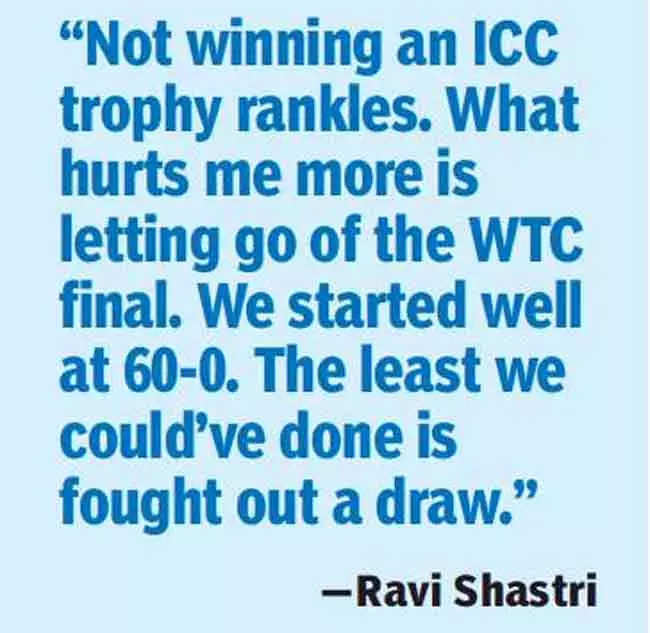
You have soaked in so much negativity on behalf of the team…
There was always a lot of negativities around but luckily, I had no time for all of that. But those who know me well will know what a thick-skinned guy I am for such things to affect me.
The more I saw people getting jealous of what this team kept achieving, the more I laughed at their insecurities. The more some people wanted this team to fail, the better we did.
What was working with Bharat Arun and R Sridhar like?
Champion coach. I’ve known him since 1979 and have seen him not just coach cricketers but coach coaches, set up their curriculums, hand over Level-3 certificates at NCA. A thoroughly ingrained coach and someone who I’d seen from very close quarters.
Sridhar’s intensity levels as a professional were high. Arun recommended him and it turned out to be a good choice. He was clinical in his approach and worked well with data.
Dropping Ambati Rayudu for 2019 WC
I had no say in that. But I wasn’t okay with three wicketkeepers being picked for the World Cup. Either Ambati or Shreyas could’ve come in. What was the logic in having MS Dhoni, Rishabh and Dinesh all together? But I never interfered with the selectors’ work, except when I was asked for feedback or as part of a general discussion.
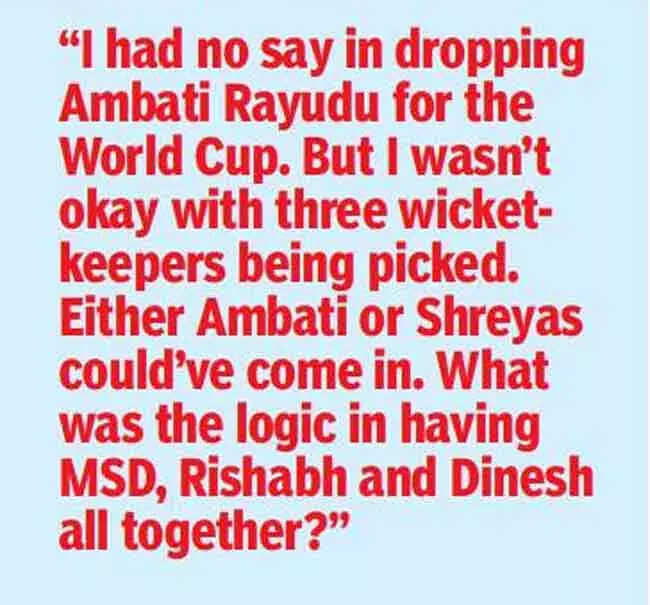
Why was Ajinkya Rahane dropped for the Cape Town Test?
It was always going to be between Rohit and Ajinkya. There was no space for both. Rohit had got runs and we had been watching that Test hunger build in him. So, we went by form.
Dropping Cheteshwar Pujara in first Test in England…
We told him. He wasn’t in great form, and he understood why it was being done. I personally told him. And in fact, dropping him in that Test did wonders. He came back with a lot of hunger, and it showed in the ensuing Tests.
What will Ravi Shastri do next…
I’ll spend time with mom and family. Have spent a lot of time away from them. And then, let’s see, I’ve always been open to newer challenges and I’m just 59-going-on-60. There’s another decade of good work to do.
Credit: Source link



